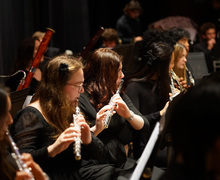Short-handed Orange roster may become even thinner this weekend
Every week during practice, Syracuse assistant coach Erin Little literally must work as a coach on the court.
Due to Syracuse only having 11 players it uses on the roster, Little, who played at SU from 2008-11, must practice with the team every day just so it can run six-on-six scrimmages during practice.
But as Syracuse heads on the road this weekend to take on No. 18 Duke (18-3, 9-1 Atlantic Coast) on Friday at 6:30 p.m. and Wake Forest (14-8, 3-7) on Saturday at 6:30, its already small roster may be shrinking. Gosia Wlaszczuk did not play last weekend, although she practiced Tuesday and dressed for SU’s (10-12, 5-5) victory over Clemson on Sunday. Redshirt freshman Valeriya Shaipova, who has played a key role in the Orange’s recent victories, left the court on crutches Tuesday after it appeared her knee gave out at the end of practice.
While the Orange travels south with a short-sided bench, its opponents, the Blue Devils and the Demon Deacons, have 15 and 12 players, respectively.
“I know it is unfortunate when we have injuries, we don’t really have a lot of subs,” redshirt junior captain Lindsay McCabe said. “But again, the benefit of having a small team is that we’re all really close.
“We’re all used to playing with each other. Everyone’s a contributor so that always builds good team morale.”
Having a smaller team limits some of the things the team can do in practice, as evidenced by Little, a coach needing to practice with her players.
Teams such as No. 2 Penn State, which has 19 players on its roster, have the advantage of being able to do more in practice. Teams with larger roster sizes cannot only do six-on-six scrimmages without the coaches, but also more positional specific drills that improve techniques specific to position, Little said.
Having a large roster size can slow a young player’s development, though. On game days, many players never get to see the court. This can be hard when younger players begin to get starting opportunities when they are older, but have not had much match experience.
“When you have a larger team, a lot of the girls are on the bench,” Little said. “They don’t get to see as much playing time, and it’s hard that way.”
Little, who also has experience playing with small rosters and large roster sizes, believes as a coach she can better develop her players with a smaller team.
“With a small roster, you know you can keep it, the group tight,” Little said. “You can work more in depth with players. So like rather than having to focus on 18, you can focus on just the 11, focus on getting them better.”
Although several players on the team said that they enjoy the small roster, many would argue that teams like Penn State have had so much success with a larger roster size for a reason.
For sophomore Silvi Uattara, however, she does not believe that the team would improve if it had more players.
“Our team is small but we’re all really close and really good friends,” Uattara said. “I don’t think that if we had more players on the roster we would be better.”
Published on October 31, 2013 at 1:10 am
Contact Ryan: rlraigro@syr.edu





